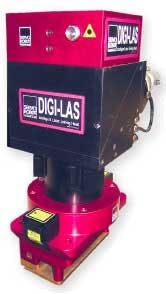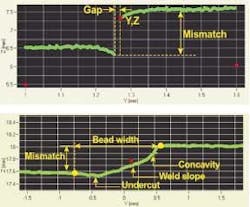Intelligent laser welding
This increasingly popular industrial laser process promises increased quality, ease of use
Laser welding is a fast-growing industrial laser process with a wide range of applications. Continual improvements are being made with laser welding equipment to make it more robust and easier to use. Intelligent laser welding is the application and integration of smart sensors that provide the desired feedback to close the process control loop.
The laser welding process requires monitoring of several parameters to ensure a good-quality, repeatable weld. The monitored parameters can be divided into three specific areas: pre-weld monitoring (part fit-up and seam tracking), active weld monitoring (process monitoring), and post-weld monitoring (weldment inspection and verification).
Adaptive integration of these monitored feedback signals to the laser and motion control system is essential to control and maintain the laser welding process. "Add-on" monitoring sensors have been used with great success to increase process robustness but do not represent a standard, easily integrated solution. To overcome these issues, technology is now available which incorporates the unique advantages of various sensors integrated within a single "intelligent" laser process head (see Figure 1).
The integration of monitoring sensors can be categorized based on their placement (before, during, or after welding) and method of application. Available sensors include the following:
null
- Laser power sensing. You can check the laser output power at any time by programming the laser head to perform a power check into an onsite laser power sensor. Then you can compare the output power to a known acceptable value. This check can highlight any problems with the laser resonator, external beam delivery, and optics.
- Laser focus sensing. The use of a 3D laser vision sensor can correlate, correct, and maintain the proper focus position via triangulation. This ensures that the proper energy density of the laser focus spot is maintained over a workpiece of varying shape.
- Plasma sensing. An ultraviolet (UV) sensor can measure the plasma emission to determine if the actual ultraviolet light level, plasma signal, and signal frequency match the original signature associated with a good-quality weld. Laser focusing errors, shielding gas interruption, and several other conditions can be determined. In addition, weld penetration and defects can be detected which are related to the space charge voltage and plasma temperature.
- Reflective light sensing. An infrared (IR) reflective light sensor analyzes the amount of infrared reflected light from the weld process and compares it to the optimum level of a good weld signature. The infrared emissions can be related to the weld penetration depth and weld surface quality.
- Laser head temperature sensing. Internal sensors are designed to monitor the laser welding head temperature to ensure it stays below an acceptable maximum. This can catch a potential problem before it damages the head or adversely affects the welding process.
- Weld pool sensing. The use of a 3D laser vision camera sensor enables sensing of the weld pool size, shape, and location (with respect to the seam) and compares it to allowable tolerances.
- Joint tracking sensing. Seam tracking incorporates the use of a camera sensor to measure, correct, and maintain the proper laser beam focus position to keep it properly aligned with the joint (see Figure 2).
- Adaptive welding sensing. Application of a real-time fit-up (gap size) measurement function incorporates the selection of different weld schedules capable of handling the changing joint. Power level, travel speed, and cold wire addition are just some of the possible variables that can be adapted.
- Acoustic emissions sensing. The sound of a process sometimes can provide useful information about its stability. The acoustic spectrum can be compared to a predetermined optimum signature to determine if a defect such as porosity is present.
- Weld dimension sensing. A GeoScan system is capable of measuring the complete geometry of the finished weld and can compare the results to a company or industry standard (see Figure 3).
- Pinhole sensing. A Poroscan system is designed to detect all holes ranging from burn-through to surface porosity. Pinholes as small as 0.3mm can be detected reliably at speeds of up to 8.0m/min.
- Adaptive welding sensing. Traditional adaptive welding is done by using the tracking information from the leading sensor. However, it is also now possible to use the finished weld measurements from the trailing sensor to do closed-loop feedback.
- Weld spatter sensing. The IR detector is capable of measuring the amount of weld spatter being created by the process compared to a known signal and spatter level. Excessively high spatter can indicate an out-of-control process.
- Weld pool temperature sensing. Monitoring the temperature of the weld pool and its homogeneity can indicate if the weld nugget is being created properly.
Conclusion
A wide variety of process monitoring sensor options are available with the Intelligent Laser Welding Head. The integration of these sensors with adaptive controls is essential to close the process control loop. This new technology is far superior to the previous approaches of individual "add-on" sensors. The modular design of the intelligent laser process head allows the unit to be built to specific customer requirements and facilitates true sensor fusion. It provides the end user with a complete integrated solution that has the additional benefits of reduced physical size, simplified programming, quicker setup, and easier troubleshooting. This means more production time and better weld quality.
Gilbert Haas ([email protected]) is president of Haas Laser Technologies, Inc. (Flanders, NJ). Jeff Noruk ([email protected]) is president of Servo-Robot Corp. (Mequon, WI).



